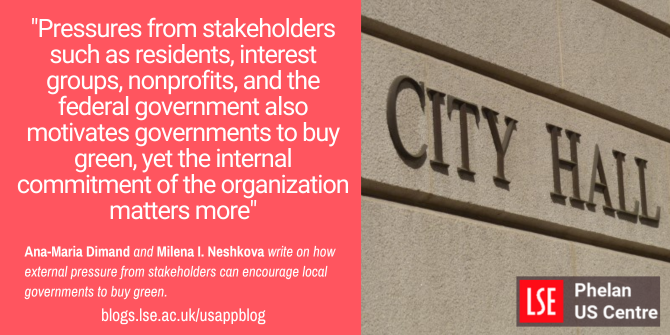
 Making informed choices about what we buy and who from can be an effective way to support more sustainable businesses and practices, and this applies to governments as well as individuals. Ana-Maria Dimand and Milena I. Neshkova examine what motivates local governments to practice Green Public Procurement when they outsource goods and services. They find that pressures from external stakeholders and the internal commitment of an organization play a key role in institutionalizing green procurement in local governments. Public administrators can be engines of innovation, especially when green policies are not established yet.
Making informed choices about what we buy and who from can be an effective way to support more sustainable businesses and practices, and this applies to governments as well as individuals. Ana-Maria Dimand and Milena I. Neshkova examine what motivates local governments to practice Green Public Procurement when they outsource goods and services. They find that pressures from external stakeholders and the internal commitment of an organization play a key role in institutionalizing green procurement in local governments. Public administrators can be engines of innovation, especially when green policies are not established yet.
Public Procurement for Climate Change Mitigation and Social Equity
Public procurement has traditionally been used to enhance government efficiency through outsourcing goods and services to third parties. Now, it encompasses the broader objectives of sustainability and social welfare. In other words, the government leverages its enormous purchasing power to promote social equity and address climate change via what it buys. Green Public Procurement (GPP) is a value-based innovation that incorporates environmental criteria into governments’ purchasing. Given that shared resources, such as the environment, would be depleted by current generations if no policies were in place, GPP aims to ensure equitable resource allocation over time. GPP is part of a broader class of policies—Sustainable Public Procurement (SPP), which prioritizes purchasing from small businesses, minority- and women-owned enterprises, local vendors and using socially responsible supply chains.
Green procurement practices of governments contribute to intergenerational equity in two ways. First, they prevent the overconsumption of common resources, like clean air and wilderness, and ensure their preservation. Markets often fail to adequately consider the preferences of future generations, making GPP essential for improving the allocation of scarce resources across generations. Second, “brown” products, which production causes harmful environmental impacts, are undervalued in the market, as their prices do not account for the full cost of pollution and other externalities. While cheaper now, they perpetuate negative externalities from ecological degradation. The costs of these products are eventually borne by future generations, who did not incur them, and future governments, who will need to deal with these externalities. Although green products and services are more expensive in the short run, they are less costly in the long run. By incorporating environmental criteria into purchasing decisions, GPP accounts for environmental costs throughout the lifecycle of a product or service and alleviates the financial burden on future generations.

“City Hall” (CC BY-SA 2.0) by Neon Tommy
Unveiling the Government’s Motivations for Buying Green
Value-based innovations like GPP enter administrative practices organically, often preceding the adoption of formal GPP policies, because they align with both individual and organizational values. Our study tests whether internal organizational commitment or external pressures better predict the probability of buying green by local governments. We think of internal commitment as the stage of GPP institutionalization in an organization. The process follows the organizational learning stages, which in our case are—green predisposition, familiarity with GPP, adoption of GPP policy, and inclusion of GPP in strategic planning. Buying green is made real by the number of environmental requirements embedded at each stage of the procurement process. Thus, it reflects the everyday practice of an organization.
In our research, we find that buying green becomes more prevalent at higher stages of GPP institutionalization. Pressures from stakeholders such as residents, interest groups, nonprofits, and the federal government also motivates governments to buy green, yet the internal commitment of the organization matters more.
We also assess the interplay between stakeholder pressure and internal commitment. The data indicate that that external pressures are more likely to affect the procurement practice at the early stages of GPP institutionalization, where administrative actors lead the process. Procurement professionals, therefore, play a key role in driving value-based innovations like GPP. Interestingly, governments prioritized stakeholder demands from contractor organizations such as interest groups and nonprofits. Although businesses have traditionally opposed sustainability policies, many have invested in green technologies and developed expertise that procurement officials could tap into.
Our analysis also shows that residents’ sustainability demands matter throughout the process, not just at the early stages of institutionalization. This finding highlights the importance of public engagement in pursuing green procurement. The impact of the federal government, mostly through funding availability for GPP, is only marginally relevant. This finding indicates that the federal government needs to do more to steer local governments into sustainability practices.
Lessons from American Localities: Promoting Sustainable Procurement
The experience of the American local governments in sustainable procurement offers valuable insights for other governments worldwide. Let’s explore some key lessons learned.
The Role of Public Administrators: Value-based innovations like GPP often emerge within public organizations even without formal policies in place. This highlights the crucial role of public administrators, particularly in specialized areas like public procurement, as engines of innovations.
Cultivating Internal Commitment: The traditional practice of prioritizing the lowest bidder has led to massive negative externalities and environmental degradation. To address such externalities, governments must consider the long-term impact of their purchasing decisions. By avoiding brown products that disregard the cost of pollution, governments can act as responsible stewards for future generations and improve intergenerational equity.
The Power of Public Demand: Governments are responsive to the concerns of residents. When citizens support greater environmental sustainability, public officials strive to meet their demands. This responsiveness is observed throughout the institutionalization process, with both politicians and administrators acting as representatives of the public interest.
The Role of Higher-Level Governments: Higher-level governments could hold lower-level governments accountable if they do not pursue green purchasing practices. Yet, they need to develop more effective mechanisms to ensure compliance and promote environment-friendly procurement. Sharing information and best practices among governments can facilitate the development of strategies to address climate change.
Building Relationships to Create Public Value: Private and nonprofit suppliers often possess expertise in sustainability that can benefit procurement officials. Governments could also benefit from establishing long-term partnerships with experienced contractors to collaboratively design sustainable procurement processes and leverage their knowledge.
By embracing these lessons, governments worldwide can advance sustainable procurement practices and contribute to a greener future where the resources are shared more equally.
- This article is based on the paper, ‘Buying green in U.S. local government: Internal commitment and responsiveness to external pressure’, in Public Administration.
- Please read our comments policy before commenting.
- Note: This article gives the views of the author, and not the position of USAPP – American Politics and Policy, nor the London School of Economics.
- Shortened URL for this post: https://bit.ly/3rIUHvh






